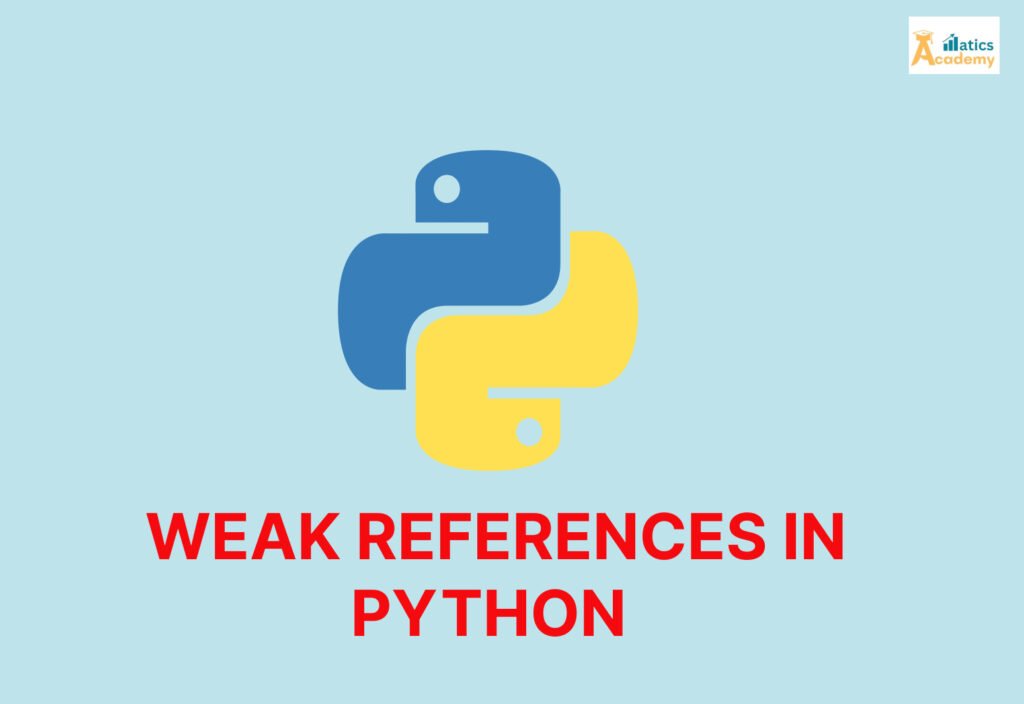Python’s weak references enable developers to reference objects without preventing their garbage collection. Weak references allow the garbage collector to reclaim an object’s memory when it is no longer needed, even if a weak reference exists, unlike standard references. This article demonstrates weak references in Python, explains their use cases, and provides examples to highlight their importance.

What Are Weak References?
A weak reference lets developers reference an object without increasing its reference count. Python tracks every object using reference counts, and the garbage collector removes objects when their reference count reaches zero. By using weak references, developers ensure they can reference an object without preventing its cleanup.
Key Features of Weak References:
- Memory Optimization: Helps manage memory efficiently by allowing the garbage collector to clean up unused objects.
- Non-Intrusive: Does not interfere with an object’s lifecycle.
- Use in Caching: Ideal for building caches where you don’t want the cache itself to prevent memory cleanup.
Why Use Weak References?
Weak references are particularly useful in scenarios where:
- Memory management: Avoiding memory leaks by ensuring objects are garbage-collected when not in use.
- Caching systems: Retaining temporary data without locking it into memory.
- Avoiding circular references: Preventing issues where objects reference each other, leading to noncollectable memory.
How Weak References Work
Python’s weakref module equips developers with tools to create and manage weak references. Developers commonly use weak references with custom objects because certain built-in types, such as integers and strings, are immutable and do not support weak references.
Example Usage of Weak References
1. Creating Weak References
The weakref.ref function creates a weak reference to an object.
import weakref
class MyClass:
def __init__(self, name):
self.name = name
obj = MyClass("Example")
weak_obj = weakref.ref(obj) # Create a weak reference to obj
print(weak_obj()) # Access the original object: <__main__.MyClass object at 0x...>
del obj # Delete the original object
print(weak_obj()) # Output: None (the weak reference no longer points to the object)
2. Using Weak References with Callbacks
Weak references support callbacks that are triggered when the referenced object is garbage-collected.
import weakref
class MyClass:
def __init__(self, name):
self.name = name
def on_object_deletion(weak_ref):
print("Object has been deleted!")
obj = MyClass("Callback Example")
weak_obj = weakref.ref(obj, on_object_deletion) # Attach a callback
del obj # Delete the original object
# Output: Object has been deleted!
3. Using weakref.WeakValueDictionary
The WeakValueDictionary is a specialized dictionary that holds weak references to values.
import weakref
class MyClass:
def __init__(self, name):
self.name = name
obj1 = MyClass("Object 1")
obj2 = MyClass("Object 2")
weak_dict = weakref.WeakValueDictionary()
weak_dict['first'] = obj1
weak_dict['second'] = obj2
print(weak_dict['first'].name) # Output: Object 1
del obj1 # Delete obj1
print('first' in weak_dict) # Output: False (entry is removed when the object is garbage-collected)
Advantages and Disadvantages of Weak References
Advantages:
- Improves Memory Efficiency: Allows unused objects to be reclaimed, reducing memory usage.
- Avoids Memory Leaks: Prevents circular references from holding memory unnecessarily.
- Flexible Caching: Ideal for temporary storage in caching systems.
Disadvantages:
- Not Supported for Immutable Types: Cannot create weak references for built-in types like strings or integers.
- Reduced Reliability: Objects can disappear at any time, requiring careful handling in code.
- Performance Overhead: Additional complexity can marginally impact performance.
Tips for Using Weak References in Python
- Use WeakValueDictionary for Caches: Create lightweight, memory-efficient caching systems with WeakValueDictionary.
- Handle Expiration Gracefully: Check if the referenced object still exists before accessing it to handle expiration effectively.
- Avoid Overuse: Limit the use of weak references to necessary scenarios to prevent code complexity caused by their unpredictability.
- Combine with Callbacks: Use callbacks to track object deletion or perform cleanup tasks efficiently.
Conclusion
Weak references in Python optimize memory usage and manage object life cycles effectively. By leveraging weakref and its features, developers create efficient, memory-safe applications. Whether building caching systems or preventing memory leaks, weak references provide invaluable tools for advanced Python programming.
INTERVIEW QUESTIONS
1. What Are Weak References in Python?
Company: Amazon
Answer:
Weak references in Python allow developers to refer to an object without increasing its reference count. This ensures that the garbage collector can still clean up the object when no strong references exist. Developers use weak references to manage memory efficiently, avoiding memory leaks, especially in scenarios involving large or temporary data structures, caching, or objects with circular references.
2. Demonstrate How to Use Weak References with Callbacks
Company: Google
Answer:
Here’s a code snippet that demonstrates using weak references with a callback:
import weakref
class MyClass:
def __init__(self, name):
self.name = name
def on_object_deletion(weak_ref):
print("Object has been deleted!")
# Create an object and a weak reference with a callback
obj = MyClass("Example")
weak_ref_obj = weakref.ref(obj, on_object_deletion)
print(weak_ref_obj()) # Output: <__main__.MyClass object at 0x...>
del obj # Delete the object
# Output: Object has been deleted!
print(weak_ref_obj()) # Output: None
3. What is the Difference Between Weak References and Regular References?
Company: Microsoft
Answer:
| Aspect | Regular References | Weak References |
|---|---|---|
| Reference Count | Increases the reference count of the object. | Does not increase the reference count. |
| Garbage Collection | Prevents object from being garbage-collected. | Allows object to be garbage-collected. |
| Usage | Used for regular object management. | Used in memory-sensitive or caching scenarios. |
| Persistence | Strongly tied to the object’s lifecycle. | Object can disappear anytime if unreferenced. |
4. Explain WeakValueDictionary and Its Use Cases
Company: TCS
Answer:
The weakref.WeakValueDictionary uses weak references to hold its values. When a value is no longer referenced elsewhere, the dictionary automatically removes it.
Real-world Scenario:
Imagine you are building a caching system for database queries. You can use a WeakValueDictionary to store query results, ensuring the dictionary automatically removes results when they are no longer needed elsewhere, thereby saving memory.
Example:
import weakref
class Data:
def __init__(self, value):
self.value = value
# Create a WeakValueDictionary
cache = weakref.WeakValueDictionary()
# Store objects in the dictionary
data1 = Data("Result 1")
data2 = Data("Result 2")
cache['query1'] = data1
cache['query2'] = data2
print(cache['query1'].value) # Output: Result 1
del data1 # Delete the object
print('query1' in cache) # Output: False (entry is removed)
5. How Do Weak References Prevent Memory Leaks?
Company: Infosys
Answer:
Weak references prevent memory leaks by enabling the garbage collector to clean up objects even when they are still weakly referenced. They resolve circular references effectively, where two or more objects reference each other and block their cleanup. By using weak references, developers ensure that one or more of these references do not stop the garbage collector from reclaiming the objects, thus avoiding memory leaks.
QUIZZES
Weak References in python Quiz
Question
Your answer:
Correct answer:
Your Answers
